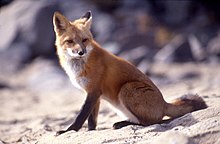Red fox
| Red Fox | |
|---|---|

| |
| Scientific classification | |
| Kingdom: | |
| Phylum: | |
| Subphylum: | |
| Class: | |
| Order: | |
| Suborder: | |
| Family: | |
| Subfamily: | |
| Tribe: | |
| Genus: | |
| Species: | V. vulpes
|
| Binomial name | |
| Vulpes vulpes Linnaeus, 1758
| |

| |
| Distribution of the Red Fox. Native distribution in blue, introduced in red. | |
| Synonyms | |
|
Vulpes fulva, Vulpes fulvus | |
The Red Fox (Vulpes vulpes) is a mammal of the order Carnivora. It has the widest range of any terrestrial carnivore[2], being native to Canada, Alaska, almost all of the contiguous United States, Europe, North Africa and almost all of Asia, including Japan. In the British Isles, where there are no longer any other native wild canids, it is referred to simply as "the fox". It was introduced in Australia in the 19th century.[3] As its name suggests, its fur is predominantly reddish-brown, but there is a naturally occurring grey morph known as the Silver Fox; a strain of tame Silver Fox has been produced from these animals by systematic domestication.
Distribution

Today, the Red Fox has a range spanning most of North America and Eurasia, southern Australia, and with several populations in North Africa.
In Australia the Red Fox is an introduced species and a serious conservation problem.[4] Introduction occurred about 1850, for recreational fox hunting,[5]
In North America the Red Fox is native in boreal regions, introduced in temperate regions.[6] There is a recent fossil record of Red Foxes in boreal North America, and one subspecies of these native boreal foxes extends south in the Rocky Mountains.[7] In temperate North America, Red Foxes are derived from European Red Foxes, which were introduced into the Southeastern United States around 1650-1750[8][9] for fox hunting,[10], and from there to California for the fur trade. The first introduction is attributed to Robert Brooke, Sr., who is said to have imported 24 Red Foxes from England.[11]. The introduced European Red Fox may have interbred with the scarce indigenous population to produce a hybrid population.[12]
Three subspecies of Red Fox are found in India: Vulpes vulpes montana (the Tibetan Red Fox), found in Ladakh and the Himalayas, Vulpes vulpes griffithi (the Kashmir Fox) found in Jammu and Kashmir less the Ladakh sector, and Vulpes vulpes pusilla (the Desert Fox) found in the Thar Desert of Rajasthan and in Kutch, Gujarat. A subspecies, the Japanese Red Fox (Vulpes vulpes japonica) migrated from India to China and eventually to Japan.[citation needed]
- ^ Template:IUCN2008 Database entry includes justification for why this species is of least concern
- ^ http://www.cornforthimages.com/Galleries/Wildlife/Mammals/Mammals.htm
- ^ "Vulpes vulpes". Animal Diversity Web. Retrieved 2007-08-19.
- ^ "European red fox (Vulpes vulpes)". Australian Department of the Environment and Water Resources. 2004. Retrieved 2007-09-09.
- ^ Smithsonian National Museum of Natural History
- ^ World Conservation Union (IUCN) Invasive Species Specialist Group Global Invasive Species Database, accessed 2008-02-19.
- ^ Crabtree, Bob (April–May 1998). "On the trail of a gray ghost - studying mountain gray foxes". National Wildlife Federation. Retrieved 2008-03-29.
{{cite web}}: CS1 maint: date format (link) - ^ Presnall, C.C. (1958). "The Present Status of Exotic Mammals in the United States". The Journal of Wildlife Management, 22(1). p. 45-50.
{{cite web}}: Text "r2008-02-21" ignored (help) - ^ Churcher, C.S. (1959). "The Specific Status of the New World Red Fox". Journal of Mammalogy, 40(4). p. 513-520. Retrieved 2008-02-21.
- ^ Lioncrusher's Domain -- Carnivora Species Information
- ^ "Fox Hunting and the ban - Ten things you didn't know". Icons. 2006. Retrieved 2007-11-03.
- ^ "Index of Species Information: Vulpes vulpes". Fire Effects Information System. United States Forest Service. Retrieved 2007-09-09.

